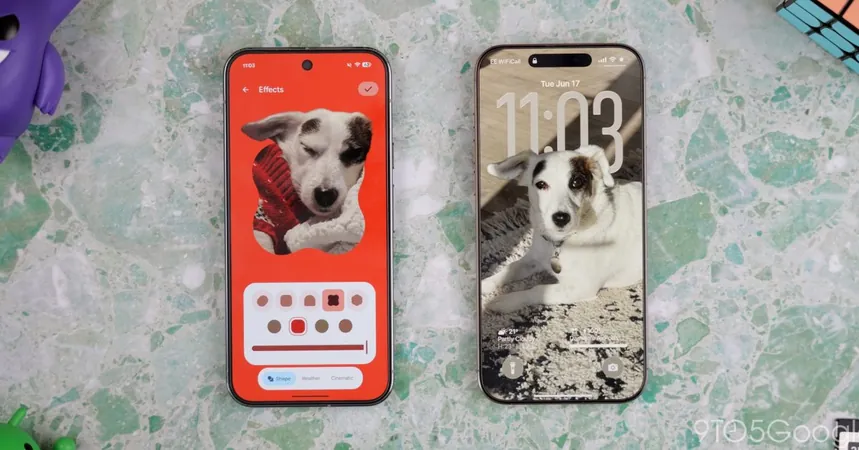
iOS 26 vs. Android 16: The Battle of Designs Gets Heated!
2025-06-17
Author: Jessica Wong
A Clash of Giants: iOS 26 vs. Android 16!
Apple has just unveiled iOS 26, a bold new direction that's drawing plenty of attention. But how does this revolutionary update measure up against the upcoming Android 16, also waiting in the wings? Buckle up as we dive into the battle of the designs!
Apple's Bold Move: Liquid Glass or Just a Splash?
Apple isn't known for following trends; instead, they prefer to innovate by adding their unique spin. However, with iOS 26, they’ve taken a leap back to the Aero-era aesthetics reminiscent of Windows Vista. While 'Liquid Glass' aims for sophistication, the execution—especially in terms of accessibility—has left many scratching their heads.
In stark contrast, Google’s Android 16, dubbed Material 3 Expressive, focuses on evolutionary tweaks rather than radical reinvention. This includes subtle frost designs that enhance visibility and user experience compared to Apple’s transparency overload.
Quick Settings: A Tale of Two Panels!
When it comes to Quick Settings, the differences are striking. On Apple's iOS 26, the panel is nearly transparent, making it nearly impossible to navigate against light backgrounds—good luck if you prefer a clean, bright wallpaper!
Conversely, Android 16 QPR1 ramps up practicality with options to add quick toggles, improving functionality while maintaining clarity!
Quality of Life Upgrades: Who's Leading?
Get ready for a twist—iOS 26 is finally introducing estimated charging times. It’s surprising that this is a first for Apple when Android users have enjoyed this feature for years. Meanwhile, Android 16 will deliver enhancements like DeX-like functionality, letting you dock your phone for a desktop-like experience.
AI Features: Are We Witnessing a Shift?
It appears that AI integration is set to be a priority for Android, with Gemini expected to outshine Siri's capabilities. Meanwhile, Apple seems to be scaling back its AI push after a robust introduction with iOS 18.
Still, Apple is dipping its toes into new features like Call Screening, showing signs of evolution. However, many of these innovations feel like late arrivals compared to established Android functionalities.
Customization: Who Does It Better?
When it comes to customization, Android 16 takes the crown. Yet, iOS still impresses with stunning lock screen options and smooth integration. Users can enjoy parallax wallpapers and effective widgets that offer glanceable utilities.
Android 16 may struggle with lock screen fluidity, but it introduces Live Effects that add a fun touch, albeit with some gimmicky moments.
Camera Experiences: Striking Similarities!
Surprisingly, both the Pixel and iPhone cameras are converging. Apple's attention to reachability means layout similarities have emerged, but Android's interface remains user-friendly and straightforward.
Final Verdict: iOS 26 vs. Android 16!
Today's showdown between iOS 26 and Android 16 shows how both platforms are increasingly melding together, with many features overlapping. The key difference now lies in whether you prefer Apple’s more closed-off ecosystem or Android’s flexible adaptability.
One final concern: let’s hope that Apple’s 'Liquid Glass' style doesn’t inspire other Android manufacturers to jump on the bandwagon. It's an interesting year ahead for mobile design—stay tuned!



 Brasil (PT)
Brasil (PT)
 Canada (EN)
Canada (EN)
 Chile (ES)
Chile (ES)
 Česko (CS)
Česko (CS)
 대한민국 (KO)
대한민국 (KO)
 España (ES)
España (ES)
 France (FR)
France (FR)
 Hong Kong (EN)
Hong Kong (EN)
 Italia (IT)
Italia (IT)
 日本 (JA)
日本 (JA)
 Magyarország (HU)
Magyarország (HU)
 Norge (NO)
Norge (NO)
 Polska (PL)
Polska (PL)
 Schweiz (DE)
Schweiz (DE)
 Singapore (EN)
Singapore (EN)
 Sverige (SV)
Sverige (SV)
 Suomi (FI)
Suomi (FI)
 Türkiye (TR)
Türkiye (TR)
 الإمارات العربية المتحدة (AR)
الإمارات العربية المتحدة (AR)